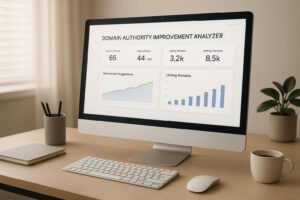Last Updated on April 9, 2025 by Becky Halls
Staying ahead in the digital marketing game requires more than just optimizing your own website; it also involves keeping a close eye on your competition. One of the most effective ways to enhance your backlink strategy is to check backlinks of competitors. By analyzing where your rivals are getting their backlinks, you can uncover new opportunities, refine your link-building efforts, and ultimately improve your website’s performance and ranking.
In this guide, we’ll walk you through the steps to check backlinks of competitors, provide valuable insights, and introduce you to the best tools for analyzing competitor backlinks. Let’s dive in!

Why Checking Competitor Backlinks Matters
Understanding your competitors’ backlink profiles offers several benefits:
- Identify Link-Building Opportunities: Discover new websites and platforms where you can acquire backlinks.
- Understand Competitor Strategies: Learn what works for others in your industry and adapt those strategies to your own efforts.
- Improve Your SEO Performance: By enhancing your backlink profile, you can boost your website’s authority and search engine rankings.
- Stay Ahead of Industry Trends: Keep up-to-date with the latest link-building tactics being used in your niche.
Understanding Backlink Types
Different types of backlinks can impact your strategy and SEO outcomes in various ways. Editorial backlinks, which are created when another site voluntarily links to your content as a reference, often carry significant weight due to their organic nature.
Guest blogging links, derived from writing articles for other websites, enable you to showcase expertise while acquiring backlinks. Directory links, where your site is listed in online directories, can help increase visibility though search engines may not weigh them as heavily.
Steps to Check Backlinks of Competitors
1. Identify Your Top Competitors
Before you can check backlinks of competitors, you need to know who they are. Identify the websites that rank higher than yours for your target keywords.
Tips:
- Use Search Engines: Simply search your primary keywords and note the top-ranking websites.
- Leverage SEO Tools: Tools like SEMrush or Ahrefs can help identify competitors based on shared keywords.
2. Choose the Right Backlink Analysis Tool
Several tools can help you check backlinks of competitors effectively. Here are some of the best options:
- Ahrefs: Offers comprehensive backlink analysis with detailed metrics.
- SEMrush: Provides in-depth competitor backlink data and SEO insights.
- Moz Link Explorer: Useful for analyzing link quality and domain authority.
- Majestic SEO: Focuses on backlink history and trust flow metrics.
- Ubersuggest: A free tool that’s great for basic backlink analysis.
3. Analyze Competitor Backlink Profiles
Once you’ve selected a tool, enter your competitor’s domain to generate a backlink profile report. Pay attention to:
- Referring Domains: Websites that link to your competitor.
- Anchor Texts: The clickable text in the hyperlinks pointing to your competitor’s site.
- Link Quality: Assess the domain authority and relevance of the linking sites.
- Link Type: Identify whether the links are dofollow or nofollow.
Tips:
- Look for Patterns: Are there specific types of sites (blogs, forums, directories) that frequently link to your competitor?
- Identify High-Authority Links: Focus on links from sites with high domain authority for maximum impact.
Advanced Tips on Analyzing Link Quality
When assessing link quality, consider metrics like spam score, which reflects how likely a site is to be penalized by search engines. Relevancy is key—links from related niches often provide more value.
Page authority, an indicator of the link page’s strength, is just as important as domain authority. Together, these factors can help you prioritize high-impact backlinks.

4. Discover New Link-Building Opportunities
Use the insights from your analysis to enhance your own backlink profile.
Strategies:
- Reach Out to Referring Domains: Contact websites that link to your competitors and pitch your own content.
- Create Better Content: If a competitor has a popular article, create a more comprehensive version to attract similar backlinks.
- Leverage Broken Links: Find broken links in competitor profiles and offer your content as a replacement.
- Guest Posting: Identify blogs and publications that accept guest posts and have linked to competitors.
5. Monitor and Adjust Your Strategy
Regularly check backlinks of competitors to stay updated on their link-building activities.
Tips:
- Set Up Alerts: Use tools to notify you when competitors gain new backlinks.
- Analyze New Trends: If competitors start receiving backlinks from new platforms, consider exploring those avenues.
- Refine Your Approach: Continuously adapt your strategy based on what’s working for others and your own results.
Monitoring Competitor Backlinks Using Alerts
Set up Google Alerts to track when competitors gain new backlinks. By entering competitors’ URLs, you can receive notifications when they are mentioned or linked to across the web.
This proactive approach keeps you informed of their link-building activities and offers new strategies to explore.
Top Tools to Check Backlinks of Competitors
Ahrefs
Features:
- Detailed backlink profiles with historical data.
- Competitor comparison tools.
- Anchor text analysis.
Tip: Use the “Link Intersect” feature to find sites that link to your competitors but not to you.
SEMrush
Features:
- Comprehensive backlink analytics.
- Identifies toxic backlinks.
- Monitors competitor link-building campaigns.
Tip: Utilize the “Backlink Gap” tool to spot missed opportunities.
Moz Link Explorer
Features:
- Domain authority metrics.
- Spam score analysis.
- Link tracking over time.
Tip: Focus on high DA (Domain Authority) sites linking to competitors for quality link prospects.
Majestic SEO
Features:
- Trust Flow and Citation Flow metrics.
- Backlink history charts.
- Topical Trust Flow to assess link relevance.
Tip: Use Majestic to evaluate the quality of competitor backlinks based on trust metrics.
Ubersuggest
Features:
- Provides backlink data and SEO overview.
- Offers keyword suggestions.
- Free to use with limitations.
Tip: Great for beginners needing basic insights without a subscription.
Using Google Search Console for Backlink Analysis
Google Search Console provides a free and straightforward way to explore competitor backlinks. By accessing the “Links” report, you can see which sites link to your website.
While this tool primarily assists with self-analysis, using it on your own site can offer insights into what your competitors might see about you. Understanding which links point to you can guide your efforts to replicate successful strategies.
Tips for Leveraging Competitor Backlink Data
- Prioritize Quality Over Quantity: Focus on acquiring backlinks from authoritative and relevant sites.
- Personalize Outreach: When contacting websites, tailor your message to show how your content adds value.
- Track Your Progress: Use backlink monitoring tools to see the impact of your efforts.
- Stay Ethical: Avoid black-hat SEO tactics that can harm your site’s reputation.

Common Mistakes to Avoid
- Copying Competitors Blindly: Use competitor data as a guide, but tailor strategies to your unique value proposition.
- Ignoring Link Quality: Low-quality backlinks can hurt your SEO.
- Overlooking Nofollow Links: While they don’t pass SEO value, nofollow links can still drive traffic and increase visibility.
Cautions and Ethical Considerations in Backlink Strategy
Ethical practices in backlink strategies ensure long-term success and avoid penalties. Avoid link schemes, which can involve excessive link exchanges or paid links, as they can harm your site’s credibility.
Focus on transparent, white-hat SEO practices that emphasize genuine content creation and organic links for sustainable growth.
Conclusion
Learning how to check backlinks of competitors is a powerful strategy to enhance your SEO efforts. By analyzing competitor backlinks, you gain valuable insights into effective link-building tactics within your industry. Remember to use the right tools, focus on quality links, and continually adapt your strategy based on your findings.
Stay proactive, and you’ll not only keep up with your competitors but potentially surpass them in search engine rankings. Start exploring your competitors’ backlinks today and unlock new opportunities for growth!



